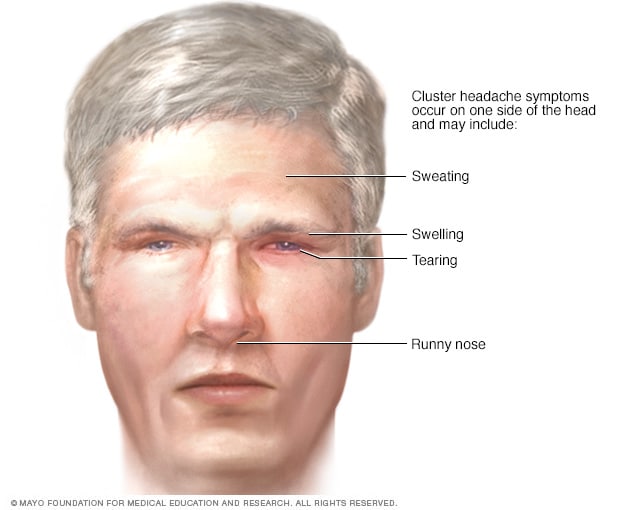Overview
Cluster headaches, which occur in cyclical patterns or cluster periods, are one of the most painful types of headache. A cluster headache commonly awakens you in the middle of the night with intense pain in or around one eye on one side of your head.
Bouts of frequent attacks, known as cluster periods, can last from weeks to months, usually followed by remission periods when the headaches stop. During remission, no headaches occur for months and sometimes even years.
Fortunately, cluster headache is rare and not life-threatening. Treatments can make cluster headache attacks shorter and less severe. In addition, medications can reduce the number of cluster headaches you have.
Symptoms
Common signs and symptoms

A cluster headache strikes quickly, usually without warning, although you might first have migraine-like nausea and aura. Common signs and symptoms during a headache include:
- Excruciating pain that is generally situated in, behind or around one eye, but may radiate to other areas of your face, head and neck
- One-sided pain
- Restlessness
- Excessive tearing
- Redness of your eye on the affected side
- Stuffy or runny nose on the affected side
- Forehead or facial sweating on the affected side
- Pale skin (pallor) or flushing on your face
- Swelling around your eye on the affected side
- Drooping eyelid on the affected side
People with cluster headache, unlike those with migraine, are likely to pace or sit and rock back and forth. Some migraine-like symptoms — including sensitivity to light and sound — can occur with a cluster headache, though usually on one side.
Cluster period characteristics
A cluster period generally lasts for several weeks to months. The starting date and the duration of each cluster period might be consistent from period to period. For example, cluster periods can occur seasonally, such as every spring or every fall.
Most people have episodic cluster headaches. In episodic cluster headaches, the headaches occur for one week to a year, followed by a pain-free remission period that can last as long as 12 months before another cluster headache develops.
Chronic cluster periods might continue for more than a year, or pain-free periods might last less than one month.
During a cluster period:
- Headaches usually occur every day, sometimes several times a day
- A single attack can last from 15 minutes to three hours
- The attacks often occur at the same time each day
- Most attacks occur at night, usually 1 to 2 hours after you go to bed
The pain usually ends as suddenly as it began, with rapidly decreasing intensity. After attacks, most people are pain-free but exhausted.
When to see a doctor
See your doctor if you’ve just started to have cluster headaches to rule out other disorders and to find the most effective treatment.
Headache pain, even when severe, usually isn’t the result of an underlying disease. But headaches can occasionally indicate a serious underlying medical condition, such as a brain tumor or rupture of a weakened blood vessel (aneurysm).
Additionally, if you have a history of headaches, see your doctor if the pattern changes or your headaches suddenly feel different.
Seek emergency care if you have any of these signs and symptoms:
- An abrupt, severe headache, often like a thunderclap
- A headache with a fever, nausea or vomiting, a stiff neck, mental confusion, seizures, numbness, or speaking difficulties, which can indicate a number of problems, including a stroke, meningitis, encephalitis or a brain tumor
- A headache after a head injury, even if it’s a minor fall or bump, especially if it worsens
- A sudden, severe headache unlike any you’ve had
- A headache that worsens over days and changes in pattern